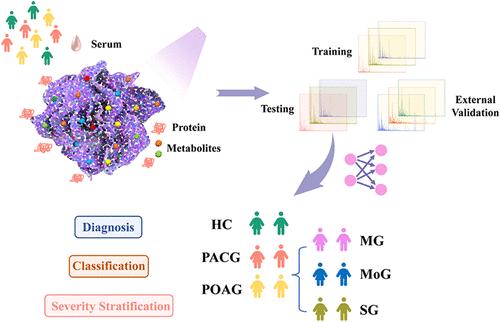Multicenter Validation of Metabolomic Fingerprints for Accurate Diagnosis, Subtyping, and Severity Stratification of Glaucoma
IF 6.7
1区 化学
Q1 CHEMISTRY, ANALYTICAL
引用次数: 0
Abstract
Timely and accurate diagnosis of primary glaucoma, along with reliable subtype and severity stratification, remains a major clinical challenge. Here, we develop a serum-based metabolomic fingerprint strategy that leverages flower-like hierarchical metal oxide heterojunctions as the matrix for laser desorption/ionization mass spectrometry, combined with a neural network algorithm. A total of 591 serum samples from two independent hospital cohorts were analyzed. In the internal test set, the model achieved exceptionally high diagnostic performance, with accuracy, F1 score, precision, and recall all reaching 1.000. External validation further confirmed its robustness, with an area under the curve (AUC) value of 1.000 and classification accuracy, F1 score, and recall each at 0.990. Subtype classification for primary angle-closure glaucoma (PACG) achieved an accuracy of 97.6%. Severity assessment of severe glaucoma showed strong performance, with an AUC of 0.990 and accuracy of 0.831. These results support the applicability of the proposed approach for precise glaucoma diagnosis and longitudinal monitoring across multicenter clinical cohorts.

代谢组学指纹图谱用于青光眼准确诊断、分型和严重程度分层的多中心验证
及时准确的诊断原发性青光眼,以及可靠的亚型和严重程度分层,仍然是一个主要的临床挑战。在这里,我们开发了一种基于血清的代谢组学指纹策略,该策略利用花状分层金属氧化物异质结作为激光解吸/电离质谱的基质,并结合神经网络算法。对来自两个独立医院队列的591份血清样本进行分析。在内部测试集中,该模型取得了非常高的诊断性能,准确率、F1分数、精密度和召回率均达到了1.000。外部验证进一步证实了其稳健性,曲线下面积(AUC)值为1.000,分类准确率、F1评分和召回率均为0.990。原发性闭角型青光眼(PACG)亚型分类准确率达97.6%。重度青光眼的严重程度评价效果较好,AUC为0.990,准确度为0.831。这些结果支持了该方法在青光眼精确诊断和跨多中心临床队列纵向监测中的适用性。
本文章由计算机程序翻译,如有差异,请以英文原文为准。
求助全文
约1分钟内获得全文
求助全文
来源期刊

Analytical Chemistry
化学-分析化学
CiteScore
12.10
自引率
12.20%
发文量
1949
审稿时长
1.4 months
期刊介绍:
Analytical Chemistry, a peer-reviewed research journal, focuses on disseminating new and original knowledge across all branches of analytical chemistry. Fundamental articles may explore general principles of chemical measurement science and need not directly address existing or potential analytical methodology. They can be entirely theoretical or report experimental results. Contributions may cover various phases of analytical operations, including sampling, bioanalysis, electrochemistry, mass spectrometry, microscale and nanoscale systems, environmental analysis, separations, spectroscopy, chemical reactions and selectivity, instrumentation, imaging, surface analysis, and data processing. Papers discussing known analytical methods should present a significant, original application of the method, a notable improvement, or results on an important analyte.
 求助内容:
求助内容: 应助结果提醒方式:
应助结果提醒方式:


